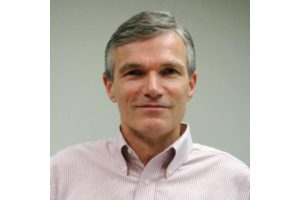
Scott Barnett will visit Hopkins on Wednesday, November 13th at 3pm for his talk, “High-Efficiency Energy Storage Using Reversible Solid Oxide Cells.” Listen to his seminar in Maryland Hall room 110!
Abstract: High-Efficiency Energy Storage Using Reversible Solid Oxide Cells
Electrical energy storage is a key technology needed for enabling increased utilization of renewable wind and solar energy resources, as needed for mitigation of CO2 emissions. While many technologies are being considered, the grid “load shifting” application – storing excess electricity for several hours until there is demand – remains challenging. This presentation will discuss the use of reversible solid oxide cells for such grid-scale energy storage. One approach is to electrolytically produce a fuel that can subsequently be used for, e.g., transportation. Another approach is similar to a flow battery – a fuel is first produced by using the solid oxide cell in electrolysis mode, stored, and then on demand converted back to electricity using the solid oxide cell in fuel cell mode. These approaches can provide large energy storage capacities when coupled with large-capacity storage of the product gases. Usually this involves steam electrolysis and storing the energy as hydrogen. Another method that can yield a high round-trip efficiency > 70% is also described, utilizing a storage chemistry where the fuel cycles between H2O-CO2-rich and CH4-rich gases. For electrolysis and reversible application, however, improved solid oxide cells are needed that can provide useful current densities at relatively low overpotentials. In order to be economically viable, they should operate for long times and many thousands of storage cycles, and hence it is important to avoid degradation mechanisms often observed during solid oxide electrolysis. The second half of this talk describes recent work done on developing improved solid oxide cells and studying their long-term stability in electrolysis mode and under reversing-current cycling. Key degradation mechanisms including oxygen electrode delamination and Ni migration in Ni-YSZ fuel electrodes will be discussed.
Bio: Scott Barnett
Scott A. Barnett is a Professor in the Materials Science and Engineering department at Northwestern University in Evanston, Illinois, USA. After receiving his Ph.D. in Metallurgy from the University of Illinois at Urbana-Champaign in Metallurgy, he held postdoctoral appointments at the University of Illinois and Linkøping University. He took his present position at Northwestern University in 1986, and has also been Erasmus Mundus Guest Scholar at University Grenoble Alpes, Fulbright Guest Professor at Centro Atomico Bariloche, Otto Mønsted Guest Professor at the Danish Technical University, Cheng Tsang Man Endowed Professor at Nanyang Technological University, and a Visiting Scientist at Los Alamos National Laboratories. He served as the founder and Chief Technical Consultant of two companies: Functional Coating Technology LLC and Applied Thin Films Inc. He has authored or co-authored > 300 publications (h index of 90), has 15 patents, and has advised nearly 50 PhD students. Research topics have included semiconductor growth by molecular beam epitaxy, ion-assisted thin film deposition, nitride hard coatings and superlattices, solid oxide fuel cells and electrolyzers, Li-ion battery cathodes, and electrode materials characterization using three-dimensional tomography and impedance spectroscopy. He is an Electrochemical Society Fellow, AVS Fellow, American Ceramic Society Fellow, and was an Office of Naval Research Young Investigator. Current research interests include development and characterization of novel fuel-cell electrode materials, energy storage using solid oxide cells and Li-ion batteries, and accelerated testing to characterize cell degradation processes.